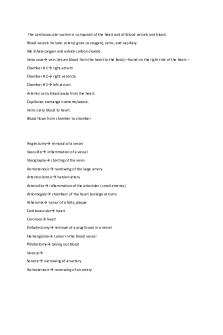Ex 37 RYK cardiovascular system PDF

| Title | Ex 37 RYK cardiovascular system |
|---|---|
| Author | NewTechs Review |
| Course | Nursing Fundamentals |
| Institution | George Mason University |
| Pages | 3 |
| File Size | 115.1 KB |
| File Type | |
| Total Downloads | 16 |
| Total Views | 131 |
Summary
Urine will back up in the tubules of the nephron and eventually will cause a high capsular hydrostatic pressure that will oppose the blood hydrostatic pressure in the glomerulus, causing a decrease in filtrate formation....
Description
Name ___________________________________ Date _________________ Section ______________________________
Reviewing Your Knowledge
A. Functions of the Nephron
EXERCISE
37
Write name of the part of the nephron that has the following function. Descending loops of Henle 1. Reabsorption of an additional 15% of water by osmosis. Impermeable to solutes. Collecting ducts 2. Hormones determine if urine is concentrated. Renal corpuscle 3. Filters blood and forms filtrate. Proximal convoluted tubule 4. Reabsorption of majority of water and solutes from filtrate by active and passive processes. Also secretion occurs here. Distal convoluted tubule 5. Reabsorption of more sodium, chloride, and about 10 to 15% more water. Ascending loop of Henle 6. Reabsorption of sodium and chloride decreases the osmolality of filtrate. Nearly impermeable to water.
B. Hormones and Urine Formation Write the term the phrase describes. Aldosterone 1. Hormone that increases sodium and chloride ion reabsorption and potassium secretion Tubular secretion 2. Process of moving substances from renal tubule into the peritubular capillary Collecting Ducts 3. ADH acts mainly at this portion of the nephron Tubular secretion 4. Process of moving substances from the peritubular capillary into renal tubule Filtration 5. Process occurring across wall of glomerular capillary and visceral layer of glomerular capsule Micturition 6. The act of voiding (emptying) the urinary bladder ADH 7. Hormone that increases water reabsorption in the late distal convoluted tubule and collecting duct E X E R C I S E 3 7 U R I N E F O R M AT I O N A N D U R I N A LY S I S
C. Urinalysis Answer the following questions with a short answer. 1.
What is the normal volume of urine output per day in an adult?
1-2 liters per hour
2.
What is the normal color of urine?
Yellow/amber
3.
What could make urine cloudy?
Infection by microbes or epithelial cells
4.
What is the normal specific gravity of urine?
1.001-1.035
5.
What makes urine have a higher specific gravity than distilled water?
Solutes
6.
Name five normal solutes found in urine.
Electrolytes, urea, creatine, uric acid, metabolic end products
7.
Normal urine contains 95 % water and 5 % solutes.
8.
Is normal daytime urine output dilute or concentrated?
Dilute
9.
What is the normal pH of urine?
4.6-8.0
10. What is pyuria?
WBC found in urine
11. What is ketonuria?
Ketone bodies found in urine
12. What is hematuria?
RBC found in urine
13. What is glucosuria?
Presence of glucose in urine
14. True or false. Normal urine has some bacteria in it even if the urine sample was taken properly. FALSE...
Similar Free PDFs

Ex 37 RYK cardiovascular system
- 3 Pages

Ex 28 RYK - Practice
- 2 Pages

Cardiovascular system
- 2 Pages

Cardiovascular System
- 2 Pages

Cardiovascular System
- 12 Pages

Module 5 - Cardiovascular System
- 2 Pages

Cardiovascular System Quiz
- 4 Pages

Cardiovascular System 2
- 13 Pages

Cardiovascular System MCQ
- 9 Pages

Cardiovascular System Lecture
- 10 Pages

Cardiovascular System Worksheet
- 5 Pages

Chapter 11 Cardiovascular System
- 4 Pages

Ch 18 the cardiovascular system
- 15 Pages
Popular Institutions
- Tinajero National High School - Annex
- Politeknik Caltex Riau
- Yokohama City University
- SGT University
- University of Al-Qadisiyah
- Divine Word College of Vigan
- Techniek College Rotterdam
- Universidade de Santiago
- Universiti Teknologi MARA Cawangan Johor Kampus Pasir Gudang
- Poltekkes Kemenkes Yogyakarta
- Baguio City National High School
- Colegio san marcos
- preparatoria uno
- Centro de Bachillerato Tecnológico Industrial y de Servicios No. 107
- Dalian Maritime University
- Quang Trung Secondary School
- Colegio Tecnológico en Informática
- Corporación Regional de Educación Superior
- Grupo CEDVA
- Dar Al Uloom University
- Centro de Estudios Preuniversitarios de la Universidad Nacional de Ingeniería
- 上智大学
- Aakash International School, Nuna Majara
- San Felipe Neri Catholic School
- Kang Chiao International School - New Taipei City
- Misamis Occidental National High School
- Institución Educativa Escuela Normal Juan Ladrilleros
- Kolehiyo ng Pantukan
- Batanes State College
- Instituto Continental
- Sekolah Menengah Kejuruan Kesehatan Kaltara (Tarakan)
- Colegio de La Inmaculada Concepcion - Cebu


